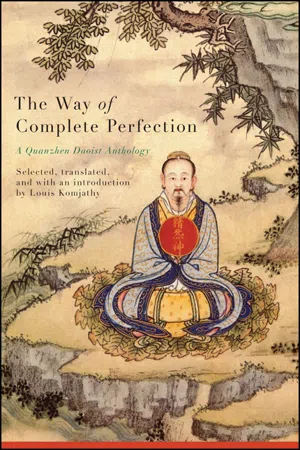![]()
Chapter One
Poetic Insights
The early Quanzhen adepts wrote voluminous amounts of poetry, only a partial record of which survives. Poetry was by far the preferred means of expression in the early Quanzhen religious community. Wang Chongyang and his first-generation disciples employed all of the major Song-Jin genres of Chinese poetry, including lyrics (ci), songs (ge),1 regulated verse (lüshi), and quatrains (jueju). Elegies (zan) are also included in some of the hagiographical collections (see chap. 6). While it is apparent that the early Quanzhen adherents studied and applied canonical Daoist scriptures (see chap. 5 herein), the preponderance of poetry and discourse records points toward the importance of context-specific teachings and personal spiritual direction. The extant poetry provides glimpses into the daily lives and activities of Quanzhen adherents as well as into their sociohistorical and communal contexts. Poems addressed to fellow adepts, lay people, and patrons reveal members of the Quanzhen community as engaged and committed teachers. There are also poems that address religious training in specific places at specific times (see Komjathy 2010). However, more often than not, it is difficult to determine the provenance of most poems contained in the literary anthologies.
The translation of Quanzhen poetry represents a major challenge, especially as so little Daoist poetry has been translated to date. One of the principal difficulties involves composing readable and sound English renderings. This challenge is complicated by the relative vagueness and hermeneutical openness of many of the poems. On the basis of literary merit, execution, and significance, few connoisseurs of Chinese poetry would probably designate Quanzhen poetry as worthy of “anthologization.” It might simply be categorized as “devotional” or “religious poetry” (cf. Schipper and Verellen 2004, 1127–33, 1142–43). However, the poetry does provide glimpses into the lifeworlds of these religious practitioners. In addition to the challenges of creating readable English poems and interpreting the technical terminology in accurate ways, the syntactic and hermeneutical openness of the poetry allows a number of equally viable and accurate translations/interpretations. Here it is important to note that I have translated certain poems using a personal voice (first-person; “I”), while others poems are presented as addressed to the reader, with frequent use of second-person pronouns (“you”) and an imperative voice. The former provide a sense of the personal dedication among the early adepts with respect to their own self-cultivation; the latter suggest a larger communal context, including a concerned attempt to inspire others to embrace and remain committed to Daoist practice. A third challenge involves selecting representative works. Every selection is an interpretation, and one is well advised to remember the partial nature of any presentation. As I understand early Quanzhen as an ascetic, alchemical, and mystical movement (see Komjathy 2007a), I have selected poems that emphasize religious praxis. The poems translated herein provide clear glimpses into and representative expressions of the early religious community.
In the present chapter, I have thus selected poems that express some of the primary concerns and commitments of the early adepts. These include a rejection of ordinary and mundane ways of life, in which dissipation, distortion, and disorientation are the primary defining characteristics. For the early Quanzhen adepts, a dedicated religious life required ascetic commitments, self-cultivation, and alchemical transformation. The present selection includes poems by most of the early adherents, specifically by Wang Chongyang and the so-called Seven Perfected. The poems cover such topics as skeletons and marionettes,2 renunciation and seclusion, meditative and alchemical praxis, and spiritual realization. I have included some of the most famous and influential verses, such as the “Wuzhen ge” (Song on Awakening to Perfection) by Wang Chongyang and the “Qingtian ge” (Song of the Clear Sky) by Qiu Changchun. In addition, I have included all of the extant poems that can be reasonably and reliably attributed to Sun Buer, the only senior female member of early Quanzhen.3
In the first three poems on skeletons and marionettes, we find the early adepts emphasizing the dissipation and meaninglessness of leading an ordinary life. For these religious adherents, ordinary human beings, those not engaging in Daoist cultivation, resemble walking corpses and puppets. These translations are followed by Wang Chongyang's “Song on Awakening to Perfection,” a poem that contains biographical details on the founder of Quanzhen and provi...
